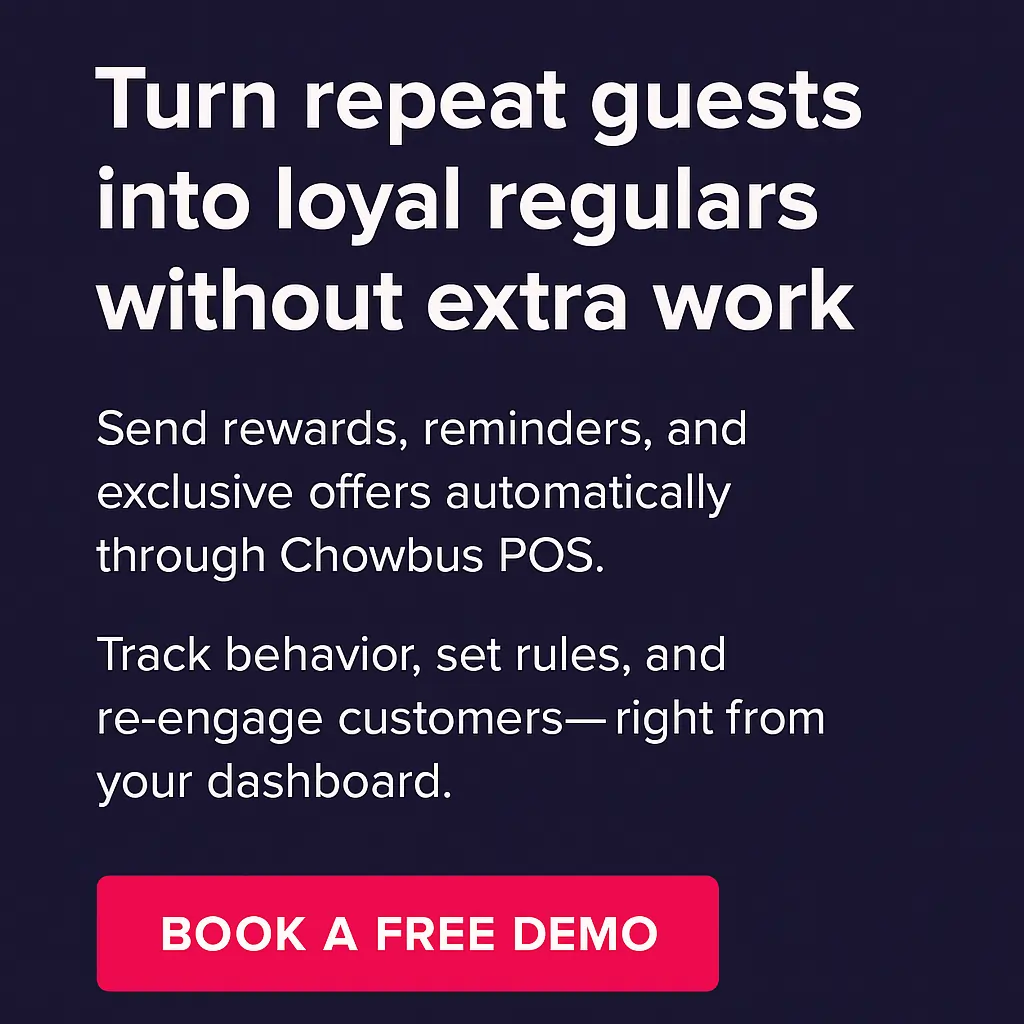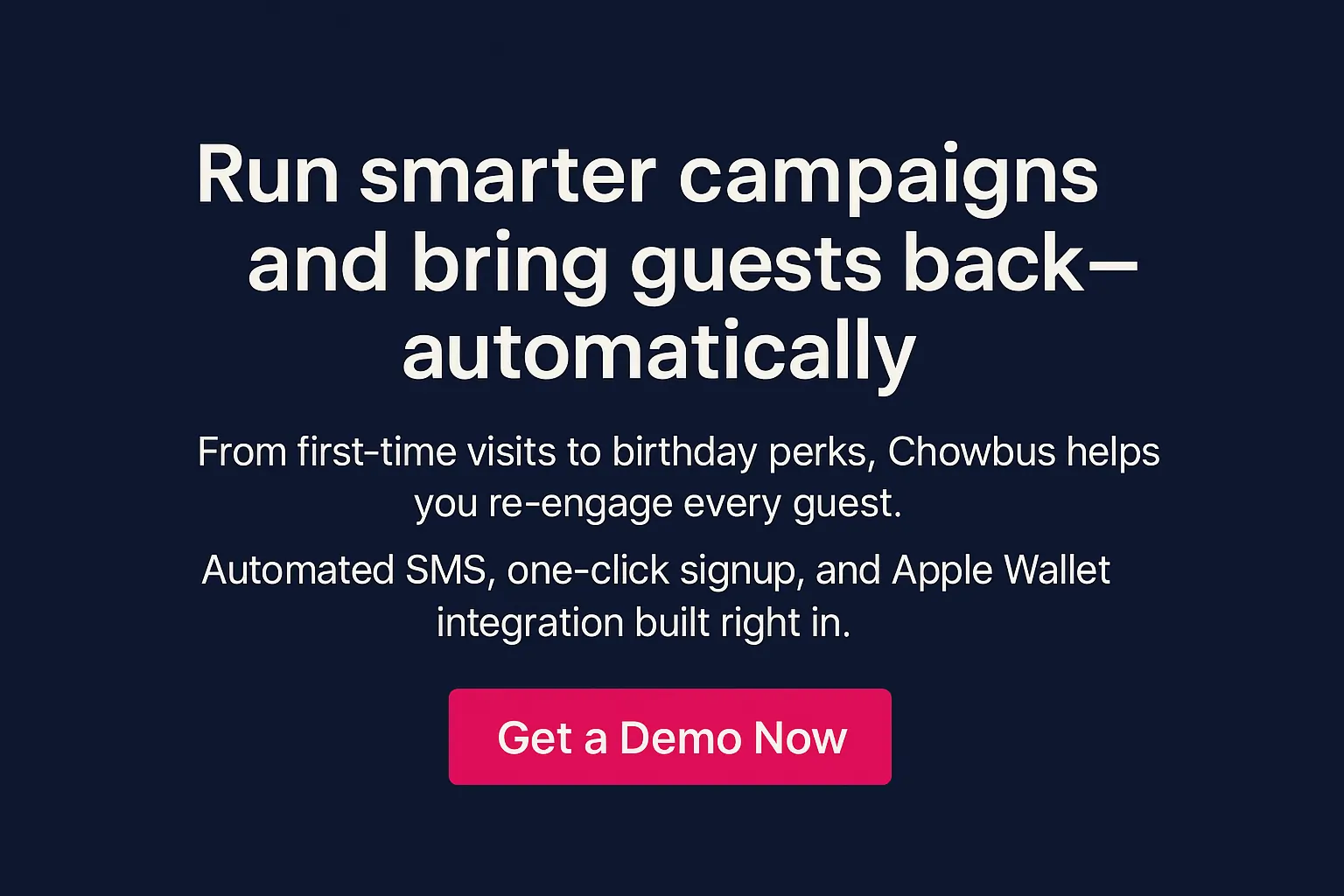
Rising costs, lower foot traffic, and fierce competition are hitting restaurants from every angle. Limited-time deals can bring a temporary boost, but they don’t keep guests coming back.
Brand loyalty programs give restaurants a smarter way to build lasting relationships. According to Restaurant Dive, loyalty members visit 20% more often and spend 20% more than non-members.
In this post, you’ll learn how a brand loyalty program can turn first-time diners into regulars, scale across multiple units, drive repeat purchases, and support smarter marketing. You’ll also see examples of the best brand loyalty programs in action and how to choose one that fits your operations.

A brand loyalty program rewards repeat guests for choosing your restaurant again and again. It’s a simple system that encourages more visits by offering perks such as points, discounts, cash back, or exclusive menu items.
Here’s how it typically works:
Some programs include tiers that unlock better rewards as guests spend more. Others offer free, prepaid, or annual memberships with different benefits.
Most modern systems sync across all ordering channels, giving you full visibility into guest behavior. When integrated with your POS and CRM, they help you segment your audience, personalize promotions, and increase repeat orders without extra work.
Big chains have teams, budgets, and tech stacks. You have your food, your service, and your community. A brand loyalty program gives you another tool, one that helps turn guests into regulars without stretching your resources.
Here’s how it helps level the field:
You’ve worked hard to bring guests through the door. Loyalty rewards give them a reason to return. Offer a first-order discount, then follow it with points or cashback to build habits. Repeat visits become routine.
Chains may rely on apps or blanket promotions. You can offer personal, location-specific perks like:
The best part? You control the rewards. Pick what works for your menu and margins.
You don’t need to hire extra staff or invest in custom development. With a POS-integrated system, you can:
There’s no separate platform to manage. Everything runs where you already take orders.
When guests sign up, you gain access to real data:
You can use that data to fine-tune promotions and focus on what works, without needing spreadsheets.
Instead of running broad discounts, target past visitors with personalized offers. A loyalty program helps you:
A loyalty program gives you more control over your marketing and lets you bring people back without over-discounting.
A solid brand loyalty program helps you grow your base by focusing on the customers who already love your food. It’s not about trying to match a chain’s budget. It’s about making the most of your guest relationships automatically, consistently, and at your pace.

Growth brings complexity. Managing loyalty across 10, 50, or even 100 locations requires more than basic rewards. You need consistency, visibility, and tools that adapt to your operations without adding overhead.
A centralized loyalty system keeps your program aligned across locations while giving you flexibility where it counts. Members can earn and redeem points at any store, and your team can manage rules, campaigns, and reporting from one place.
Here’s how a scalable approach supports multi-unit operations:
This structure helps streamline marketing, measure performance at scale, and maintain strong connections with your most valuable guests.
Loyalty programs give your marketing team the tools to strengthen relationships and increase guest lifetime value. A connected system helps you run campaigns across every channel, making it easier to keep your guests engaged wherever they interact with your brand.
A strong loyalty setup lets you:
When your loyalty program connects directly with your CRM, you gain a full view of each guest’s interactions. This makes it easier to segment your audience, personalize promotions, and track ROI. By unifying loyalty with your marketing tools, you build a system that strengthens retention, encourages higher spend, and delivers measurable results.

The best brand loyalty programs focus on simplicity, real value, and consistent customer engagement. They give guests a reason to return, reward them for doing so, and make the process seamless across ordering channels. Here are a few standout examples worth noting:
Starbucks built one of the most recognized loyalty programs in the industry. Guests earn stars with every purchase, which they can redeem for drinks or food. The program integrates directly with their app and POS, making it easy for customers to track rewards, reload funds, and place orders. Personalization also plays a role, as users receive targeted offers based on their purchase history.
Chubby Cattle’s annual membership model offers premium rewards for frequent diners. Members earn points through purchases and redeem them for high-value items like cocktails or Kobe beef. Using Chowbus’s POS and tablet ordering system, the restaurant added thousands of new members in one week. Their loyalty program also includes birthday perks and exclusive pricing, all synced across devices.
Bakery 1908 connects loyalty features across multiple locations, allowing members to earn and redeem points on over 50 menu items. Customers can register through kiosks or POS, and add their digital membership card to Apple Wallet. With more than 5,000 members joining monthly, the program runs on automation and syncs data in real time, helping the team manage high-volume traffic without added manual work.
Each of these examples shows how strong incentives, ease of use, and smart technology work together to drive repeat visits and increase customer lifetime value. When loyalty becomes part of the regular dining experience, it feels natural, not forced. That’s what makes these some of the best brand loyalty programs in the market.
The right loyalty program should feel like an extension of your daily operations, not an extra chore. It needs to be simple to run, easy for guests to join, and flexible enough to grow with your business. Here's what to look for when selecting a loyalty system that works across your front-of-house and digital channels:
Make it easy for guests to sign up. Staff should be able to enroll customers directly through the POS. You can also offer one-click registration through self-service kiosks, QR code menus, and tablets. Every ordering channel should support fast and consistent membership onboarding.
Give guests choices. Some may prefer free membership with basic perks. Others may want to top up their balance for better discounts or exclusive offers. Annual plans can appeal to frequent diners looking for premium benefits. Supporting all three—free, top-up, and paid—lets you match different customer behaviors.
Look for a system that works directly with your POS. This allows guests to access their benefits instantly during checkout. Staff can apply discounts, check balances, and track redemptions without leaving the register.
Reconnect with past customers through built-in SMS or MMS campaigns. You can send reminders to members who haven’t returned in a while, welcome new sign-ups, or offer birthday deals. Setting up these campaigns once and letting automation handle the rest saves time and keeps guests engaged.
Access clear loyalty reports inside your dashboard. See which benefits drive repeat visits, which members are most active, and how much revenue comes from loyalty users. This insight helps you fine-tune your program and focus on what brings in results.
Set up point systems based on your pricing, operations, and goals. Let guests earn points on purchases, redeem for select menu items, or unlock exclusive pricing. You control the structure, redemption tiers, and benefits by location or category.
A strong loyalty program stays consistent across dine-in, takeout, and delivery. Members should enjoy the same benefits no matter how or where they order. If you run more than one location, look for cross-store membership features that allow shared points, redemptions, and member data.
Choose a loyalty platform that keeps enrollment simple, benefits clear, and management centralized. When everything works together, you’ll spend less time on setup and more time building relationships with your best guests.
Customer loyalty builds stronger businesses. A well-run brand loyalty program doesn’t just reward purchases. It encourages habits, drives engagement, and makes every visit easier to repeat. With the right tools in place, you can attract new guests, re-engage past ones, and make each interaction more meaningful. Loyalty is one of the simplest ways to increase visit frequency, reduce marketing waste, and build a customer base that grows with you.
Chowbus POS makes loyalty simple. You can offer first-order perks, cash back, and exclusive pricing, all managed directly through your POS, QR code menus, kiosks, and tablets. Membership cards work with Apple Wallet to remind guests to return when they’re nearby. Set up free, top-up, or annual memberships that match your service style and guest preferences.
Segment your audience, automate outreach, and reconnect with lapsed diners through SMS or MMS campaigns. Adjust reward rules, track usage, and review real-time performance in your dashboard. Whether you run one store or a growing group, our system keeps loyalty consistent across channels and locations.
Book a free demo with Chowbus POS today and discover how a unified loyalty program can automatically turn everyday guests into repeat customers.

Get quick answers to common questions about loyalty programs designed to drive repeat visits and boost customer engagement. This section helps clarify core concepts and dispel common misconceptions so you can make smarter decisions faster.
A tier based loyalty program rewards members with increasingly valuable benefits as they reach higher spending levels. Customers start at the base tier and progress to higher tiers like Silver, Gold, or Platinum by accumulating points or making purchases. Each new tier unlocks exclusive perks, creating a sense of achievement and encouraging more frequent spending to maintain or reach the next status level.
No, CRM is not a loyalty program.
Think of a Customer Relationship Management (CRM) system as the central brain that stores all your customer data. A loyalty program is a specific strategy or tactic that uses that data to reward and engage customers.
Your CRM supports your loyalty program by providing the insights to personalize rewards and communications, but the program itself is the active execution of those loyalty-building activities.
In short, CRM is the toolbox; your loyalty program is one of the key tools you build with it.
The 3 R's of loyalty are Recognition, Reward, and Relevance.
No, loyalty programs are more than just a marketing tactic. While they do help brands attract and retain customers, well-designed programs also provide real value, such as discounts, exclusive perks, or personalized rewards that benefit loyal shoppers.
Most loyalty programs fail because they offer rewards that customers don’t value, make enrollment or redemption too complicated, or lack proper promotion. Successful programs stay simple, provide meaningful benefits, and keep members engaged with clear communication and consistent updates.
Check out our blog section for more insights and updates on loyalty strategies, POS solutions, and restaurant marketing trends.

Recommended Articles: